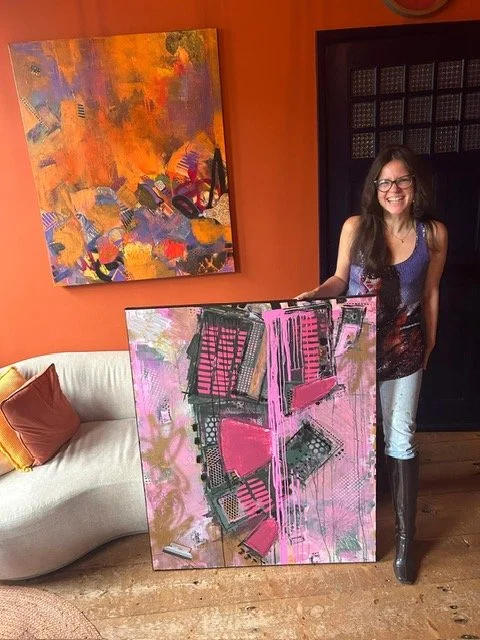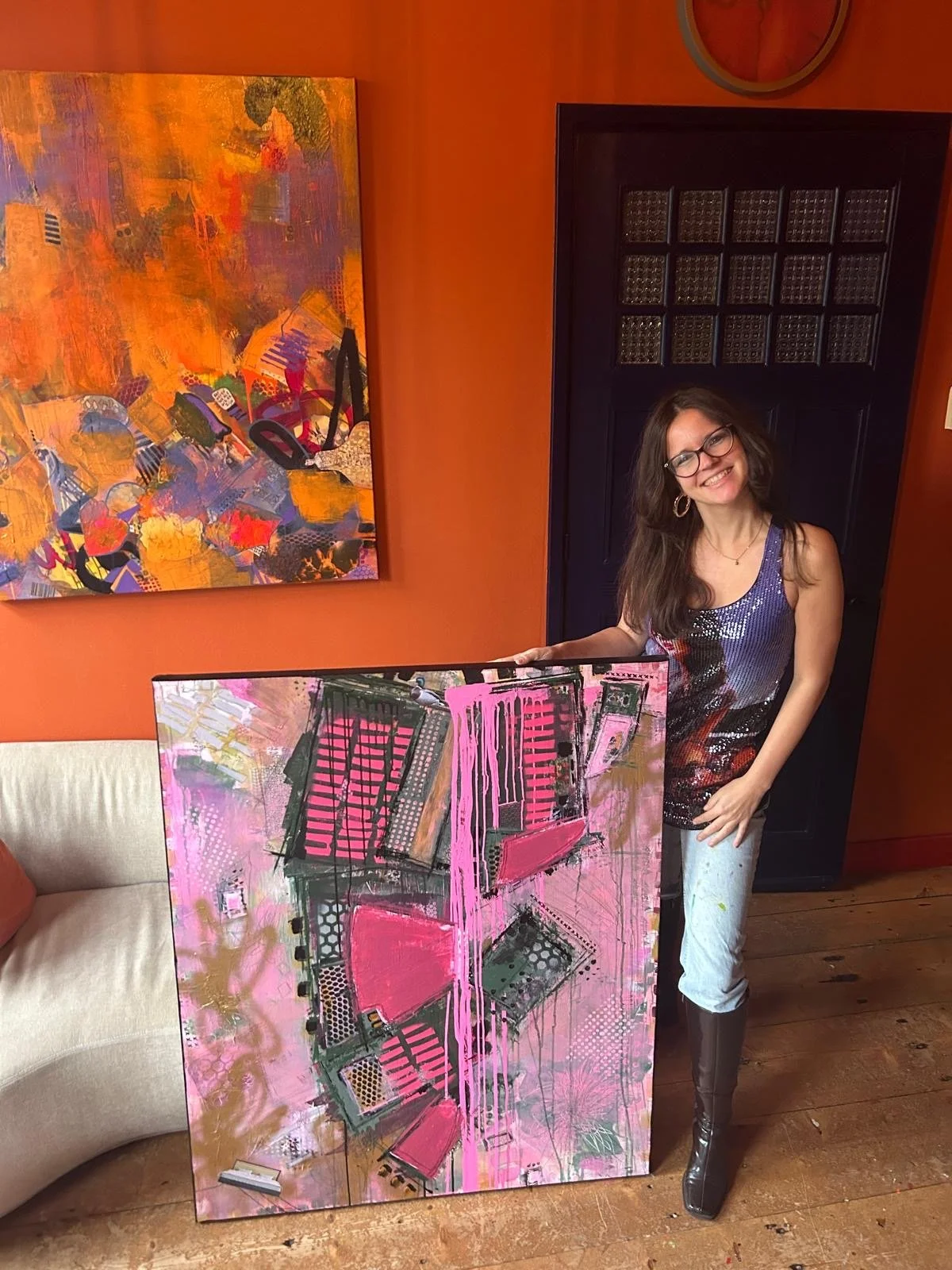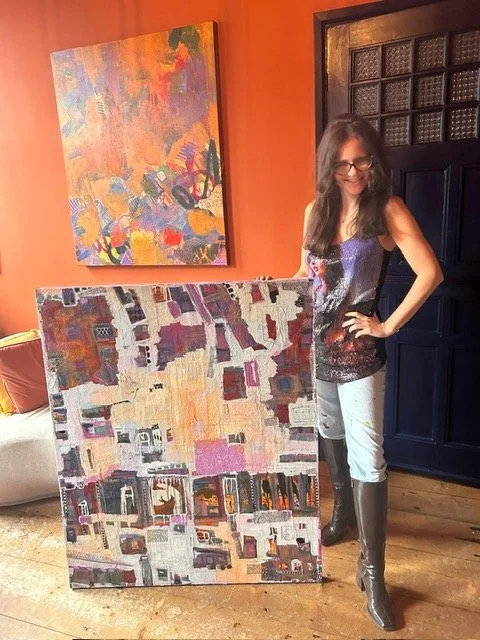Interview
Priscilla Visser
Priscilla is a soul-driven, self- taught abstract artist based in The Netherlands, whose work explores the tension between chaos and order, freedom and confinement. With a background in Hotelschool Management, she first pursued a corporate path that never truly felt like her own. Even then, she was unconsciously scanning the world around her - fabrics, patterns, symbols and colours - collecting the visual language that would later become her art. Watching Sex and the city became an escape where she could dive into a universe of breathtaking clothing, striking patterns and poetic words. That input, stored quietly over years, became her foundation - a way to shift her world. Climbing the corporate ladder and achieved status after status, she eventually fell into a space of nothingness - one that urged her to dig deep in her own heart. After a period of illness, her soul woke up, guiding her to pick up the brush and transform adversity into beauty.
Her layered paintings combine acrylics, metallics, neons, spray paint, markers, pencils, collage, texture - bold and unfiltered works that carry both raw honesty and playful joy. Priscilla's mission is to break down barriers between mind and heart, and to remind people that freedom, hope, and fun are always on the menu. She kept shifting her own energy and walked into new grounds that once felt unsafe - yet every time she stepped forward, the ground rose to support her. Today she encourages other people to do the same.
What is your background and how did you start your journey in the art world?
“I didn't study art in the traditional sense- my journey has been entirely self-taught, guided by intuition and curiosity. for over twenty years, I collected inspiration unconsciously: patterns, symbols, shapes, fabrics and paintings that stirred something in me. I developed a sixth sense for how colours, textures and forms communicate, but I wasn't so much aware. The true beginning came when I fell ill. My body was breaking down because I was walking the wrong path - climbing the corporate ladder, doing everything to make others happy, and ignoring myself. There were days I couldn't lift my arm and my boyfriend needed to dry me after a shower with a towel. It was then when I realized that I had become ill because of my mental programming and the choices that I made unconsciously. I let go of everything I thought I was. In that uncomfortable spot of being so lost, my soul woke up. From a deep well in my heart, it began to guide me, placing a brush in buy hand. That was when I realized my true language had always been art. Piece by piece, as I glued my mixed media paintings, I was glued back together as well. Painting became the gateway back to myself - a girl that was lost - a way to transform adversity into beauty, to reclaim freedom, to release negative thought patterns, and to communicate from the most honest place within me. Art came to me when I was completely naked and every part of my identity was stripped away, that is when my real life began. In those moments I realized that I could make art that would help the people around me to find their way back as well. I found the pure intention of my soul through art.”
What inspires you?
“I am inspired by artists who cannot be anything other than themselves. Those who regardless of how the enviornment responds, take a rebellious approach and insist on putting their vision into the world. That kind of courage fascinates me and gets me going. Banksy, for example, intrigues me not only because of the work itself, but because of the uncompromising authenticity and rebellion behind it. Visually I am obsessed with how color and shape can exude feeling - how the combination of elements can create entire worlds. Pop art carries its own electricity, graffiti has a raw visceral energy: both are stand-alone universes to me, escape routes that remind me there is always beauty to be found, no matter what is happening in the world outside. But more than anything, I am inspired by human happiness - not in the superficial sense, but the deep emotional kind. We often lose ourselves in the noise of the environment, our focus scattered in a thousand directions. The more input we take in, the more likely we are to drift away from our real selves.
My inspiration is to paint as a way of breaking down those barriers and to re-direct focus, to realign us with the possibility of feeling joy and honesty again. I am also deeply drawn to friction, tension and contradiction. They explain how both the body and the environment function - always challenged, always seeking balance. There is day and night, relaxation and tension, walking and resting. We live in a world of opposites, constantly pulled between extremes, and I feel most alive when those contrasts echo back in my work. Above all, freedom, inspires me. I believe that in our society we lose it far too easily - our minds and bodies pressed into constant performance. I used to think that was normal, but now I see it as inhumane. True freedom, to me, lies in the way our cells can move when they are ignited by inspired action. Sometimes we are trapped in what we think is 'normal', blind to what else could be out there. my inspiration is to push those horizons, to seek out what lies beyond, and to hold on to the idea that we can live not just in survival, but in ecstasy. I paint to be free - free from noise, from perfection, from everything that keeps us small without us realizing it. In doing so, I claim it for you and me.”
What themes do you pursue? Is there an underlying message in your work?
“The themes I pursue are deeply tied to my own life: chaos and harmony, freedom and confinement, vulnerability and resilience. My work is about the tension between those extremes - how they challenge us, shape us, and ultimately bring us back to balance. The underlying message in my work is one of honesty and hope. i want my paintings to remind people that beauty lies in imperfection, that barriers can be broken, and that there is always a way back. - to joy, to balance, to the truth of who we are. But alongside that depth, there is also playfulness. I believe fun is essential, not as a distraction, but as a vital part of healing and being alive. That is why my company slogan has always been: Colours by P - Let's have some fun. For me, fun means freedom: the freedom to experiment, to play with color and texture, to feel joy in the act of creating. So while my art carries a message of resilience and hope, it also invites people to smile, to feel lighter, and to remember that life can be playful too. Because freedom means not just surviving, but remembering how to play.”
How would you describe your work?
“I would describe my work as soul-infused abstract expression - layered, textured, and filled with energy. My paintings are built up over time with different media: acrylics, metallics, markers and pencils, graffiti markers, spray paint, stencils, collage, textural pastes, heavy gels and even glitter. I love combining materials because it creates tension and intrigue, just like life itself. Visually, my work moves between chaos and harmony, - bold, expressive gestures, alongside delicate details. Emotionally , it is both raw and hopeful. I want my canvases to feel alive, to carry a pulse, almost as if each one breathes its own rhythm. In my work shapes tell a story on their own. They speak through the canvas. At its core my work is bold and unfiltered. It is out there, unapologetically expressive, carrying energy straight from within. But also serendipitous. Meaning and intrigue emerge in the way colours and shapes come together unexpectedly, as if the canvas organizes itself. In those moments, something begins to come alive, and I know the work has found its truth.”
Which artists influence you most?
“The artists who have influenced me most are Jackson Pollock and Banksy. Pollock inspires me through the raw energy of his process. His paintings are not about control or perfection, but about letting movement, instinct, and material take the lead. That sense of freedom - of creating something alive by surrendering to the process- is something I deeply relate to in my own practice. The fact that his work speaks because it revolves around the energy and the movement, is deeply fascinating to me. Banksy fascinates me because of his uncompromising rebellion. He reminds me that art is not only about aesthetics, but about courage - daring to be unapologetically yourself, even if it challenges the world around you. His work proves that art can be both playful and political, humorous and deeply serious at the same time. Together, these influences mirror the essence of my world: Bold, unfiltered inner expression combined with a message that pushes for freedom, honesty and hope without compromising any authenticity.”
“I would describe my work as soul-infused abstract expression - layered, textured, and filled with energy.”
What is your creative process like?
“My creative process is intuitive, layered and honestly - a bit of a mess. my studio floor is usually covered in scraps of paper, textures and media scattered everywhere. It mirrors the way I work: chaotic, experimental, alive. I never start with a fixed plan: instead, I let colors, textures and gestures guide me. I work with many different media: acrylics, metallic paints, graffiti markers, collage papers I sometimes make myself, texture pastes, even glitter. Each layer shifts the energy of the canvas, and I keep building until something begins to breathe. My insecurities always show up in the process - they whisper doubts as I paint - but I've learned they are not my true self. Painting is my way of moving beyond them, of choosing honesty over fear. There's always friction in my process. On one hand, I paint to overcome perfectionism - to let go, to be free.
On the other hand, I do want to reach a certain point, a result that feels right. That tension between freedom and control never goes away, and in many ways, it is the heartbeat of my work. I often step back, watch and wait until a serendipitous moment arrives, when shapes and colours align unexpectedly and the canvas feels alive. That's when I know the work has founds its truth. It also often at that point when a title just pops in my head and I know what I have been painting all along. I always stop painting when I feel something special myself. my rule is simple; if I don't feel it, I don't expect others to. Every painting carries that moment of truth - raw, unfiltered, imperfect and alive. So my process is messy and unfiltered - but that's where the truth comes alive.”
What is an artist’s role in society and how do you see that evolving?
“I believe an artist's role in society is to open up space -space for feeling, for honesty, for imagination. In a world that often pushes us toward speed, performance and perfection, art reminds us that there are other ways of being. It slows us down, invites us to feel deeply, and connect us to something real. For me, the role of an artist is not about creating beauty, but to create meaning. Artists are bridges: between chaos and harmony, between mind and heart, between what is and what could be. We are there to remind people that freedom is possible. that joy and honesty matter, and that even in turbulence there is always a way back to balance. I believe the role of art will only become more crucial. Sitting down and taking the the time to really look at something that intrigues us can help us feel again - it nurtures our yin energy. Yin energy, to me, is restorative, soft, healing. In our busy society, it is often lacking, leaving us overworked, neglected, stressed out and disconnected from our true selves.
Art also holds the power to create paradigm shifts. By bringing hidden truths to the surface, it can pull us away from what we think we know and open us up to what can become. In that way, art not only restores us, but transforms us- helping us discover new grounds within ourselves and the world. Art can act to the counterbalance to the noise - a quiet force that carries hope and restores harmony. I also believe art has the potential to play a much bigger role in healing. Many of our illnesses have roots in the emotional body, in past experiences that stay locked inside us. Art can help bring those emotions to the surface, giving them space to move and transform. I see a future where art is used not only in galleries, but in hospitals and healing spaces- supporting people in releasing what weighs them down, and guiding them back to balance and wholeness. Art will open the flood gates, making us lean into our soft sides and help us create again.”












